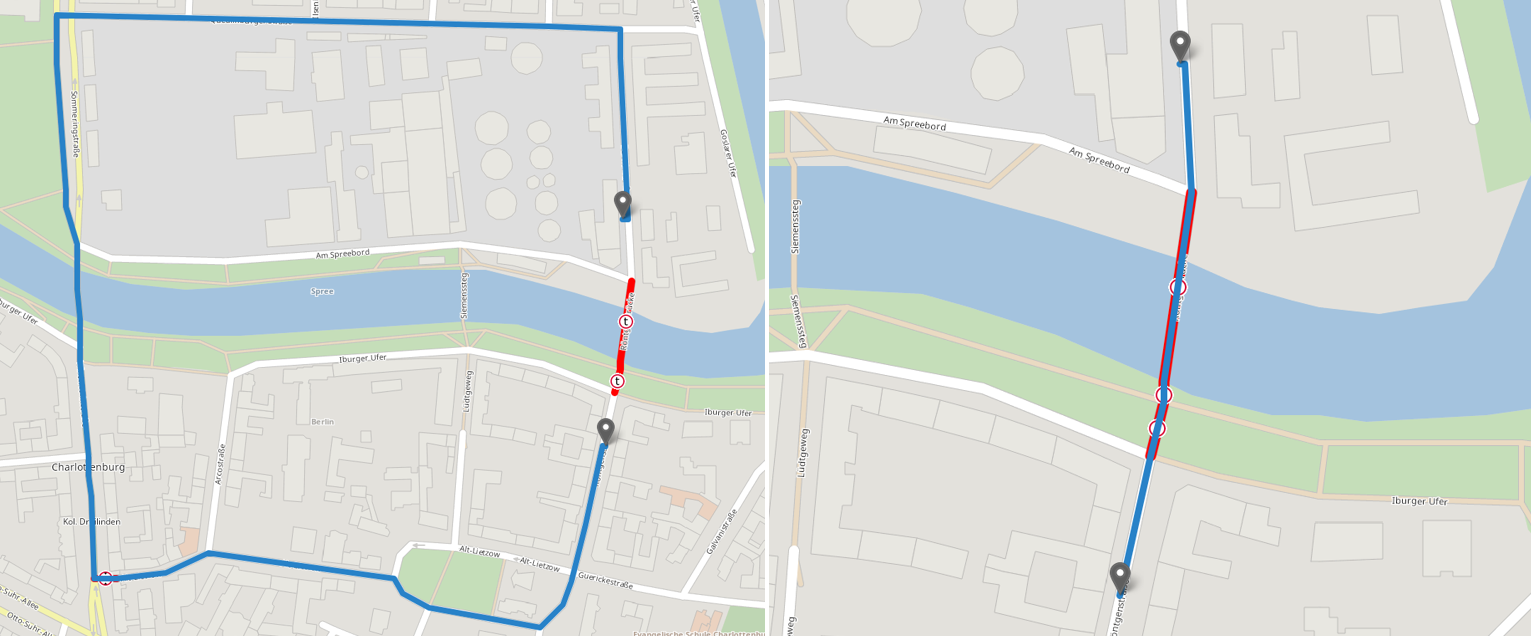Truck restrictions on roads are regulations that limit or prohibit specific types of vehicles or activities on roads. They are put in place for a variety of reasons, including environmental protection or traffic management and can vary depending on the location, type of road, and local regulations. Some common restrictions for instance include vehicle dependent factors like weight or size limits of trucks allowed or are intended on a certain time frame.
Each of these restrictions have influence on a calculated route. Routing API therefore supports the following types of restrictions on roads:
Through Traffic
As part of the EU regulations on limits for air pollutants, various regions and cities installed so-called clean air and action plans, which also include the prohibition of transit for specific vehicle types, dependent on its weight, partly on a certain time frame of a day. The route calculation therefore considers entering the zone only if the origin or destination waypoint is located within, otherwise it will be circumnavigated.
If waypoints are located outside of the restricted zone, the zone will be circumnavigated (left picture). If a waypoint is within the restricted zone, it will be entered (right picture).
Origin / Destination Traffic
Origin / destination traffic includes restricted road sections depending on the location of origin and/or destination waypoints. It allows passing certain road sections for specific vehicle types if at least the origin and/or destination is located in a specified region declared by the government. Route calculation considers these restrictions by verifying the regions where waypoints are located and therefrom allowing or blocking the certain road section.

Example "Fernpass": The B179 (Fernpass) - marked red - is closed for trucks with a total permitted weight > 7.5t - except the origin or destination waypoint is located in the declared region, then also a higher weighted truck is allowed to pass the route (left picture - Innsbruck is one of the regions). If both waypoints aren't located in one of these regions, the initial weight restriction becomes effective.
Truck Attributes
These restrictions concern the dimension, the weight or the type of the vehicle and can be important e.g. for the clearance height of tunnels or the weight restriction of bridges. Route calculation considers these restrictions by avoiding affected road sections if dimension or weight limit is exceeded. Furthermore Truck Attributes also taken into account by Matrix Routing API to gain more accuracy and a better planning basis.

If the vehicle exceed the limited weight, the road section will be avoided (left picture), otherwise it will be passed (right picture).
Tunnel Restriction Codes
When transporting dangerous goods through tunnels, the regulations of ADR (European Agreement Concerning the International Carriage of Dangerous Goods by Road) have to be observed.
- Tunnels are assigned a category A (no restriction) to E (highest restriction) which is displayed on a road sign before the tunnel.
- A vehicle is assigned a tunnel restriction code depending on what kind of dangerous goods it has loaded.
The following table shows which tunnels are restricted depending on the tunnel restriction code of the vehicle:
| Tunnel Restriction Code | Meaning |
| B | Passage forbidden through tunnels of category B, C, D and E. |
| C | Passage forbidden through tunnels of category C, D and E. |
| D | Passage forbidden through tunnels of category D and E. |
| E | Passage forbidden through tunnels of category E. |
In a routing request, always specify the tunnel restriction code of the load of the vehicle. The tunnels which cannot be passed will not be used in route calculation. Never specify the category of tunnels to be avoided.
ADR defines several codes which are a combination of these tunnel restriction codes such as B/D. That means, for tank carriage the vehicle is assigned B, for other carriage it is assigned D. In such cases specify the code which applies to the load of your vehicle. Specify B if the vehicle carries a tank, or D otherwise.
Rendering of truck restrictions
All kind of restrictions are visible by enabling truck restrictions in the Raster Maps API or in the Vector Maps API.